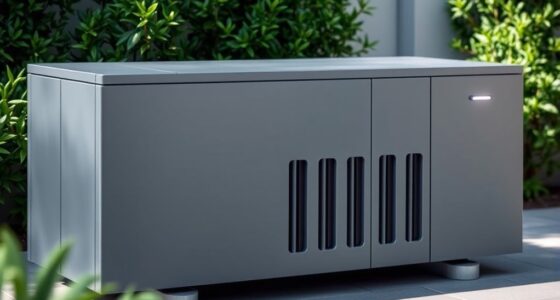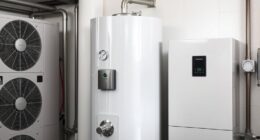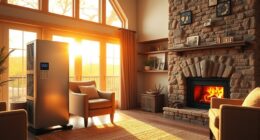To maximize duct system efficiency, keep your layout straight and direct, minimizing bends and long runs that cause pressure drops. Choose durable, smooth materials like galvanized steel or PVC, and use proper sizing according to airflow needs to prevent noise and uneven distribution. Seal all joints tightly and incorporate dampers for balanced airflow. Proper insulation and regular system checks are essential for long-term performance. Continue exploring these best practices to guarantee your ductwork operates at peak efficiency.
Key Takeaways
- Keep ducts straight, direct, and minimize bends to reduce airflow resistance and pressure loss.
- Properly size ducts based on airflow requirements to prevent noise and uneven distribution.
- Seal all joints and seams thoroughly to prevent leaks and maintain pressure balance.
- Use smooth, durable materials like galvanized steel or PVC and incorporate insulation for thermal efficiency.
- Conduct airflow testing and system validation to ensure optimal performance and identify issues early.
Optimizing Duct Layout and Routing
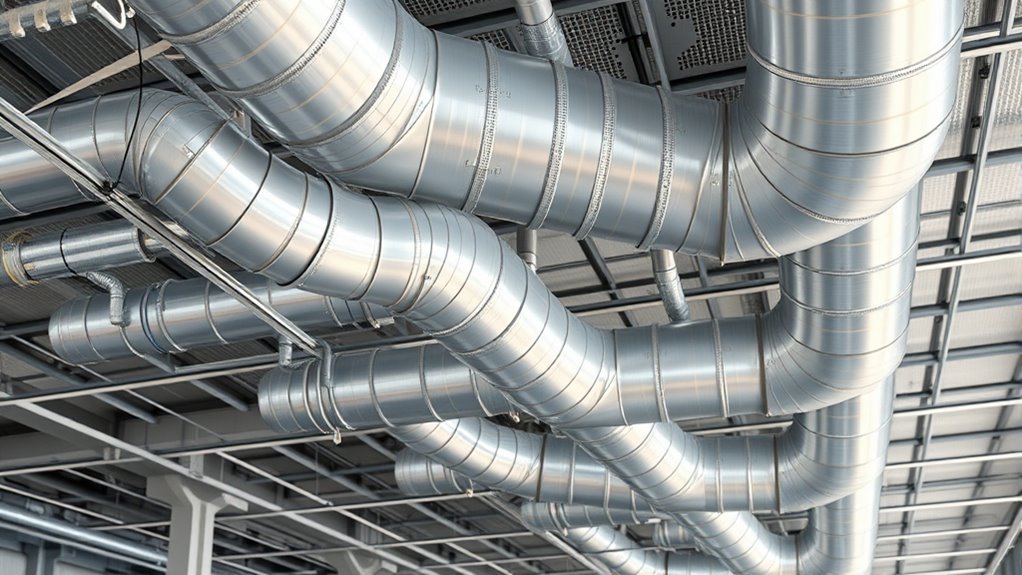
Optimizing duct layout and routing is essential for ensuring efficient airflow and reducing energy costs. When designing your duct system, consider duct material selection carefully, as it affects both durability and airflow resistance. Smooth, rigid materials like galvanized steel or aluminum minimize friction, improving efficiency. Routing complexity also plays a critical role; keep ducts as straight and direct as possible to avoid unnecessary bends and turns that increase pressure loss. Avoid tight corners and sharp angles to maintain ideal airflow. Proper layout reduces static pressure and energy consumption, saving you money over time. Planning a clear, logical path for ducts not only enhances performance but also simplifies installation and future maintenance. Additionally, understanding the flow dynamics within duct systems can help optimize design choices for maximum efficiency. Recognizing the importance of airflow patterns can lead to better placement and sizing of ducts, further enhancing system performance. By focusing on material choice and routing simplicity, you set the foundation for a highly efficient duct system.
Selecting Appropriate Materials and Insulation
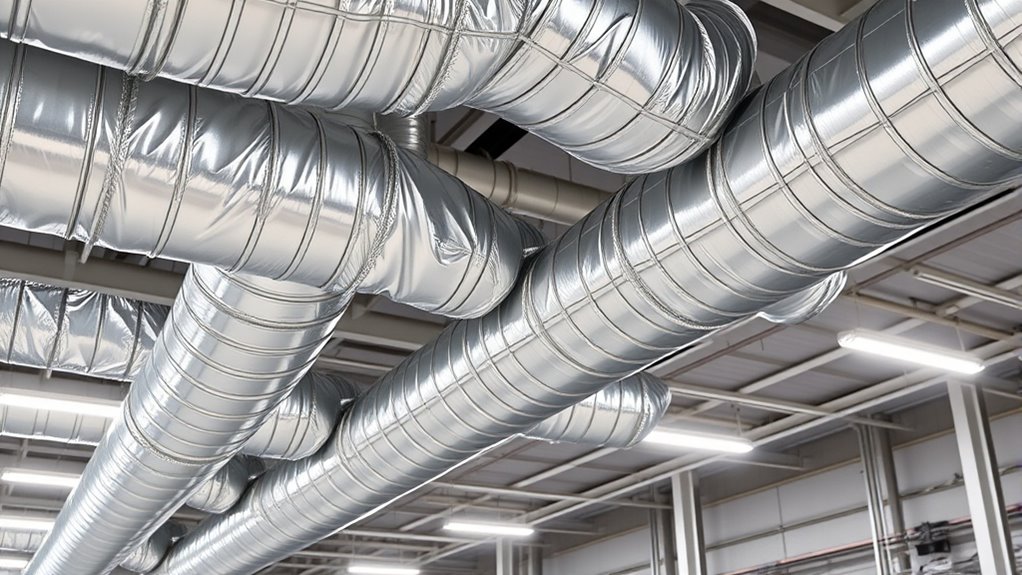
Choosing the right materials and insulation for your duct system directly impacts its durability, efficiency, and energy performance. Proper duct material selection guarantees durability and ease of installation, while effective insulation techniques minimize heat loss and noise. When selecting materials, you might consider options like galvanized steel, aluminum, or flexible ducts, each offering specific benefits. For insulation, you might choose fiberglass, foam board, or foil-backed insulation to enhance energy conservation. Visualize your duct system as a well-protected pathway: Color accuracy plays a role in how well the system maintains temperature consistency and prevents energy loss. Additionally, selecting moisture-resistant materials is essential for preventing corrosion and ensuring longevity in humid environments. – Coated, corrosion-resistant surfaces that withstand moisture. – Thick, seamless insulation layers that prevent heat transfer. – Smooth, tightly sealed joints to avoid leaks and airflow disruptions. Proper sealing techniques and airflow management are crucial to optimize system performance and energy efficiency. Incorporating proper ventilation design can further improve system operation by maintaining balanced airflow and reducing pressure losses.
Ensuring Proper Airflow and Pressure Balance
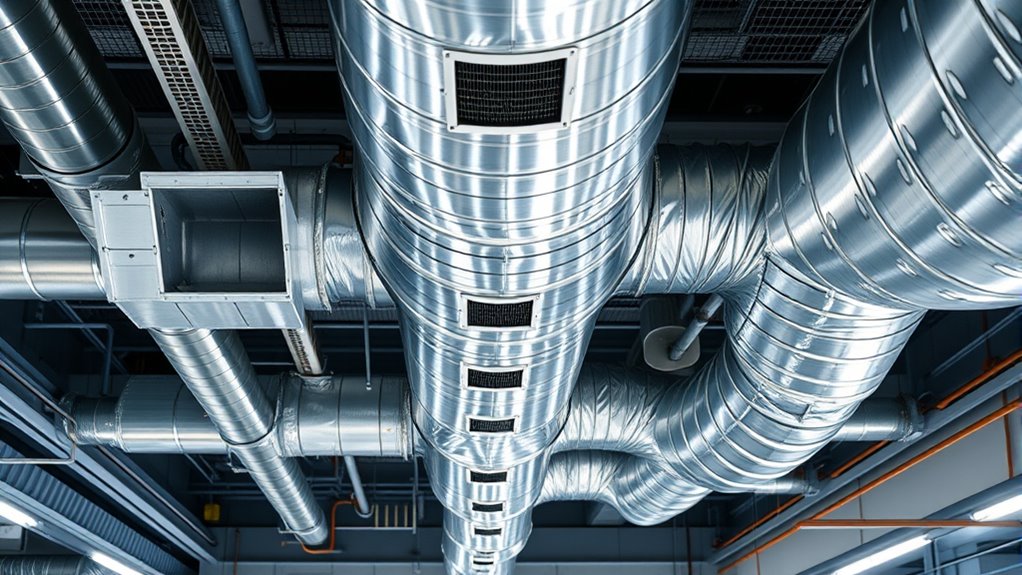
To guarantee your duct system functions effectively, maintaining proper airflow and pressure balance is essential. Uneven airflow can cause turbulence, leading to noise and reduced efficiency. Pressure imbalances may result in inadequate ventilation or overworking your HVAC system. To prevent these issues, ensure ducts are properly sealed and connected, avoiding leaks that disrupt pressure. Regularly inspect for airflow turbulence, which can indicate restrictions or obstructions. Use dampers strategically to balance airflow throughout different zones, preventing pressure imbalances. Keep duct lengths and bends minimal to reduce resistance. When airflow and pressure are balanced, your system runs smoothly, conserving energy and maintaining consistent comfort. Properly managed airflow and pressure are key to maximizing overall duct system efficiency and longevity. Additionally, understanding system design principles can greatly improve the effectiveness of your ductwork. Incorporating airflow optimization techniques can further enhance system performance, ensuring even distribution and reducing strain on components. Implementing pressure balancing strategies can also help prevent uneven wear and tear on your system parts. Regular maintenance, including leak detection, is vital to sustain optimal system operation over time. Moreover, employing proper sealing methods can significantly reduce energy loss and improve overall system efficiency.
Implementing Effective Duct Sizing and Smoothing Techniques
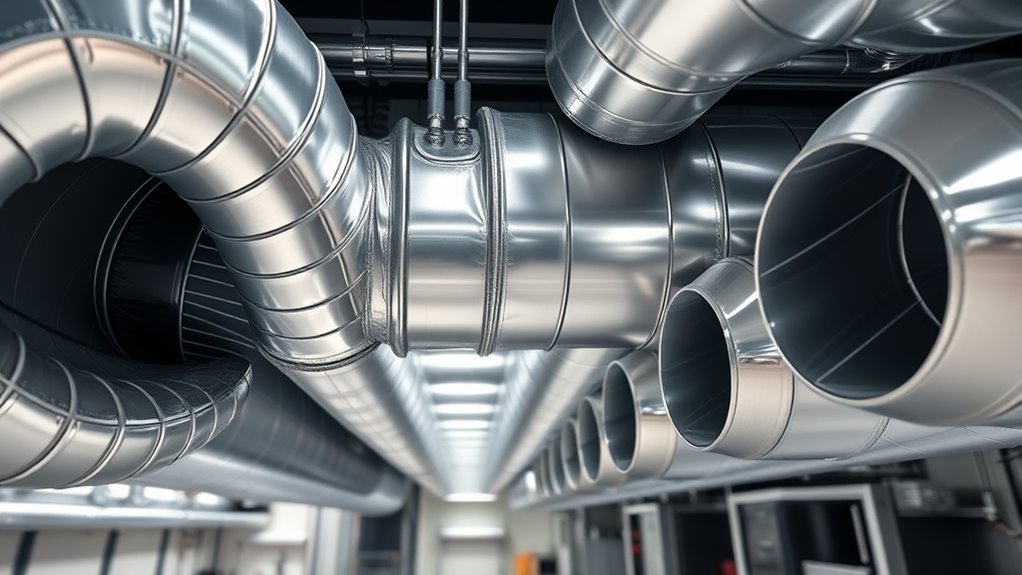
Proper duct sizing and smoothing play a crucial role in maintaining balanced airflow and pressure throughout your system. When you choose the right duct material selection, you reduce friction and turbulence, improving airflow optimization. To achieve this, focus on:
- Using smooth, rigid materials like sheet metal or PVC to minimize resistance
- Selecting appropriately sized ducts to prevent pressure drops and uneven distribution
- Incorporating gentle curves and gradual progression to avoid abrupt changes in airflow
- Ensuring that duct design adheres to airflow principles to maximize system efficiency
- Considering refrigerants and environmental impact to select eco-friendly options that support system performance
- Paying attention to filtration systems within the ductwork can further reduce dust and debris buildup, maintaining airflow quality
- Additionally, understanding duct insulation helps prevent energy loss and maintains consistent airflow temperatures
These techniques ensure your ducts are optimized for efficiency, reducing energy costs and increasing comfort. Proper sizing prevents excessive noise and strain on your system, while smoothing techniques improve airflow consistency. By paying attention to duct material selection and design, you set the foundation for a high-performing, efficient HVAC system.
Best Practices for Installation and System Testing

Effective installation and thorough system testing are essential to guarantee your ductwork performs as designed. Begin by ensuring proper duct sealing to prevent leaks that can reduce efficiency and increase energy costs. Use high-quality sealants and tape, inspecting all joints and connections carefully. Once sealed, perform airflow measurement to verify the system delivers the correct volume of conditioned air. Accurate airflow measurement helps identify imbalances or blockages that could hinder performance. Conduct pressure tests to confirm that ducts are airtight and that airflow is evenly distributed throughout the system. Document all results and address any deviations immediately. Proper installation combined with diligent testing ensures ideal airflow, prevents energy waste, and maximizes the overall efficiency of your duct system. Regularly monitoring air quality indicators can also help identify issues early and maintain optimal system operation. Additionally, understanding Louisiana alimony laws can be beneficial when planning for post-installation financial considerations.
Frequently Asked Questions
How Does Duct Design Impact Overall Energy Consumption?
Your duct design directly impacts your overall energy consumption by influencing airflow optimization and heat loss. Well-designed ducts ensure efficient airflow, reducing strain on your HVAC system and lowering energy use. Incorporating insulation strategies minimizes heat transfer, preventing energy waste. When you optimize duct size, layout, and insulation, you’ll notice improved system performance, reduced energy bills, and increased comfort in your space. Proper duct design truly makes a significant difference in energy efficiency.
What Are Common Signs of Inefficient Duct Systems?
Oh, the charming dance of inefficient duct systems—where your energy bills perform a tragic ballet. You might notice uneven heating or cooling, whispering sounds, or rooms that stubbornly refuse comfort. These signs often point to duct leakage or airflow imbalance. When ducts leak, your system wastes energy, and airflow imbalance leaves some spaces chilly while others overheat. Recognizing these signs helps you fix the issues before your utility bills become the punchline.
How Often Should Duct Systems Be Maintained or Inspected?
You should schedule duct inspections at least once every 1-2 years to guarantee ideal performance. Regular maintenance frequency depends on factors like system age, usage, and environment. Keep an eye out for dust buildup, leaks, or unusual noises, and perform thorough inspections to catch issues early. Adhering to appropriate inspection schedules helps maintain efficiency, reduces energy costs, and prolongs your duct system’s lifespan.
Can Duct Design Improvements Reduce Noise Levels?
Imagine a world where your duct system whispers instead of roars—duct design improvements can make that happen. By applying soundproofing techniques and noise reduction methods, you drastically cut down on vibrations and sound transmission. Properly designed ducts with smooth bends, insulation, and sound-absorbing materials can tame noise levels, transforming your space into a peaceful oasis. Yes, smart duct design truly can turn noisy chaos into serene silence.
What Are the Latest Advancements in Duct Materials and Technology?
You’ll find that innovative materials like lightweight composites and sound-absorbing linings improve duct durability and noise reduction. Smart technology, such as sensors and automated controls, allows you to monitor airflow and optimize system performance in real-time. These advancements help you enhance efficiency, reduce energy costs, and guarantee better indoor air quality. Staying updated on these developments empowers you to design more effective, long-lasting duct systems that meet modern demands.
Conclusion
By following these best practices, you’ll create a duct system that flows like a well-orchestrated symphony, whispering cool air smoothly through every corner. Picture your home as a cozy haven, with air effortlessly reaching each room, balanced and efficient. When you prioritize thoughtful design, quality materials, and proper installation, you’re not just maximizing efficiency—you’re crafting a comfortable, inviting space where every breath feels just right.




